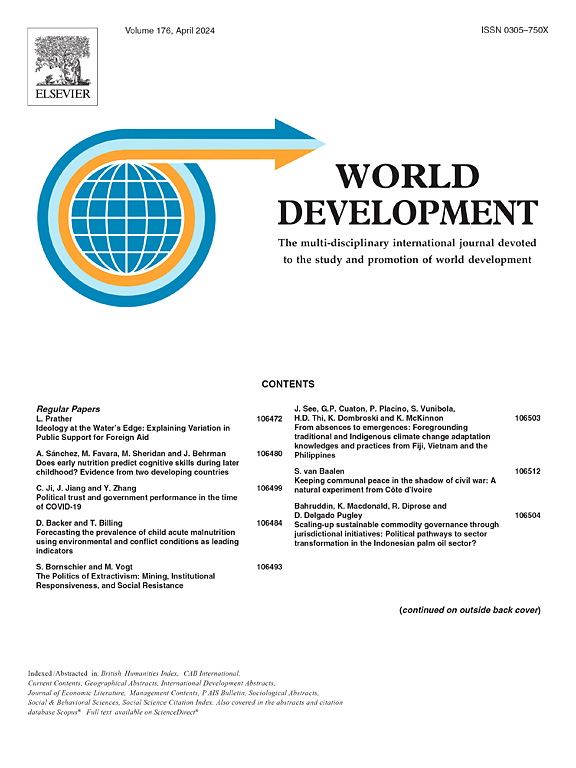交叉性很重要:对尼泊尔、塞内加尔和乌干达畜牧业妇女赋权的分析
IF 5.4
1区 经济学
Q1 DEVELOPMENT STUDIES
引用次数: 0
摘要
已经部署了许多工具来衡量发展背景下的妇女赋权,但在研究牲畜饲养者时,很少有工具明确采用交叉视角。本文采用交叉方法分析了尼泊尔、塞内加尔和乌干达畜牧业社区的定性(焦点小组讨论,fgd)和定量数据(使用妇女在畜牧业赋权指数,WELI)。我们的分析重点是尼泊尔的性别和种姓之间的交集,以及塞内加尔和乌干达的性别和种族之间的交集。71个fgd的调查结果揭示了种姓或种族群体在牲畜相关角色的性别分布以及妇女赋权概念方面的重大差异。从WELI(分别采访了821名男性和女性)得出的个人赋权得分的多变量回归表明,在塞内加尔和乌干达,即使考虑到种族因素,性别在赋权指标上的差异在统计上也很显著,但种族群体之间的进一步比较揭示了更深刻的见解。相反,在尼泊尔,不同种姓的女性(和男性)在赋权方面的差异最为明显,而每个种姓内部的性别差异则更为有限。定性调查结果通过揭示当地认为重要但未被WELI指标捕获的赋权维度,有助于进一步阐明这些调查结果。我们还比较了内在、工具和集体代理指标对不同性别和交叉群体的权力剥夺的贡献,并在fgd研究结果的帮助下讨论了所有这些差异的可能原因。我们提出建议,以改善未来的交叉分析采用WELI和混合方法的方法。本文章由计算机程序翻译,如有差异,请以英文原文为准。
Intersectionality matters: An analysis of women’s empowerment among livestock holders in Nepal, Senegal and Uganda
Many tools have been deployed to measure women’s empowerment in development contexts, but few have explicitly adopted an intersectional lens when studying livestock holders. This paper uses an intersectional approach to analyze qualitative (Focus Group Discussions, FGDs) and quantitative data (using the Women’s Empowerment in Livestock Index, WELI) for livestock-holding communities in Nepal, Senegal, and Uganda. Our analysis focuses on the intersection between gender and caste in Nepal, and gender and ethnicity in Senegal and Uganda. Findings from 71 FGDs reveal important differences in the gender distribution of livestock-related roles by caste or ethnic groups and in conceptualizations of women’s empowerment. Multivariate regressions for individual empowerment scores derived from the WELI (821 men and women interviewed separately) show that, in Senegal and Uganda, differences in empowerment indicators by gender are statistically significant even when ethnicity is considered, but further comparisons between ethnic groups reveal deeper insights. Conversely, in Nepal, the most pronounced differences in empowerment are between women (and men) from different castes, while gender differences within each caste are more limited. Qualitative findings help shed further light on these findings by unveiling dimensions of empowerment that are locally deemed important but are not captured by WELI indicators. We also compare the contribution of intrinsic, instrumental, and collective agency indicators to the disempowerment of different gender and intersectional groups and discuss possible reasons for all these differences, aided by the findings from FGDs. We provide recommendations for improving future intersectional analyses employing WELI and mixed-method approaches.
求助全文
通过发布文献求助,成功后即可免费获取论文全文。
去求助
来源期刊

World Development
Multiple-
CiteScore
12.70
自引率
5.80%
发文量
320
期刊介绍:
World Development is a multi-disciplinary monthly journal of development studies. It seeks to explore ways of improving standards of living, and the human condition generally, by examining potential solutions to problems such as: poverty, unemployment, malnutrition, disease, lack of shelter, environmental degradation, inadequate scientific and technological resources, trade and payments imbalances, international debt, gender and ethnic discrimination, militarism and civil conflict, and lack of popular participation in economic and political life. Contributions offer constructive ideas and analysis, and highlight the lessons to be learned from the experiences of different nations, societies, and economies.
 求助内容:
求助内容: 应助结果提醒方式:
应助结果提醒方式:


